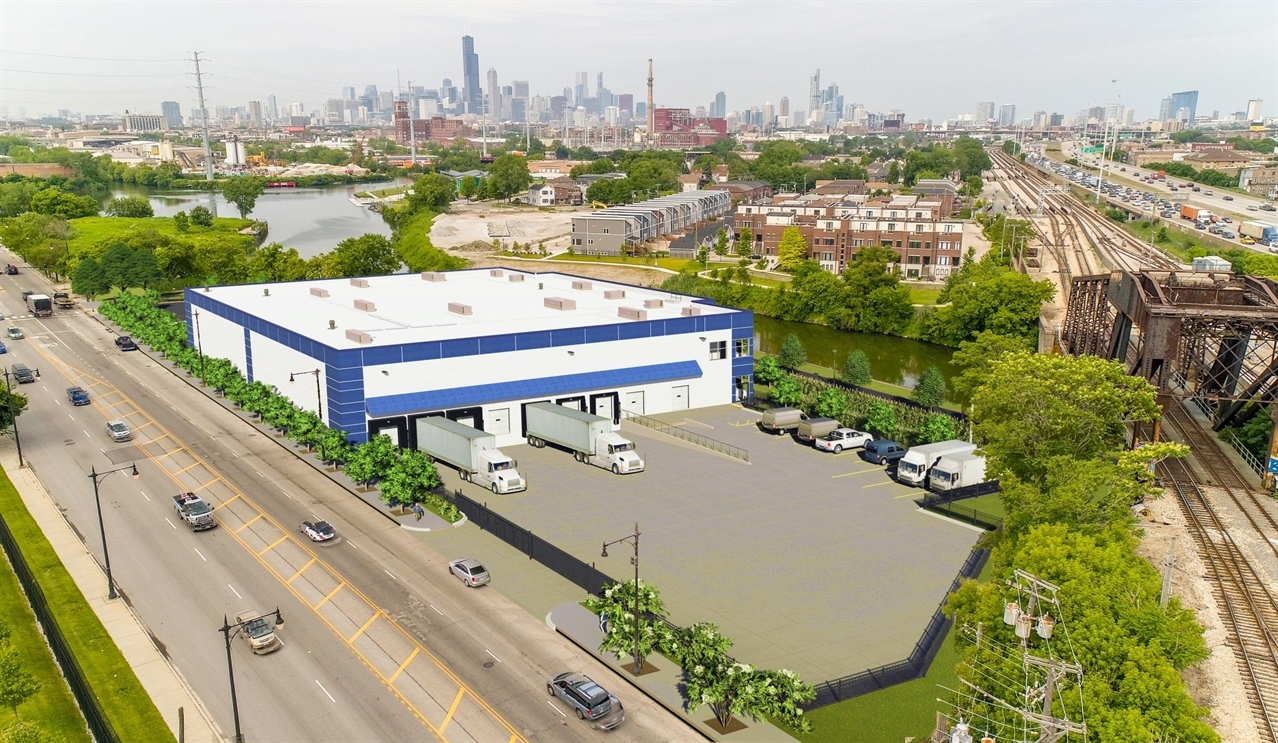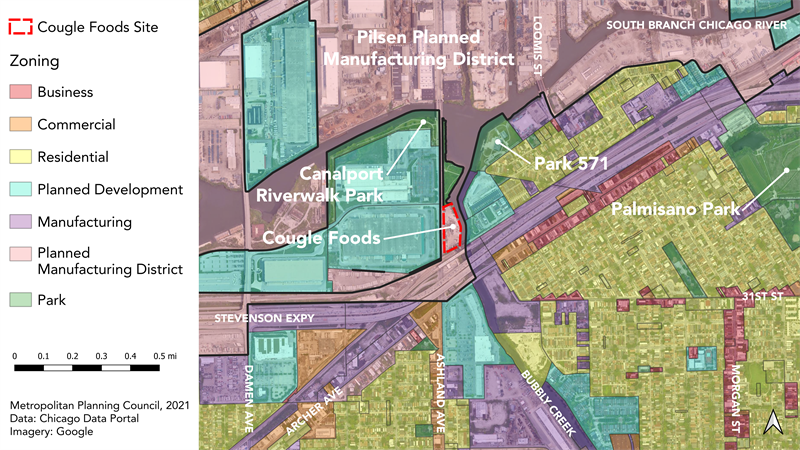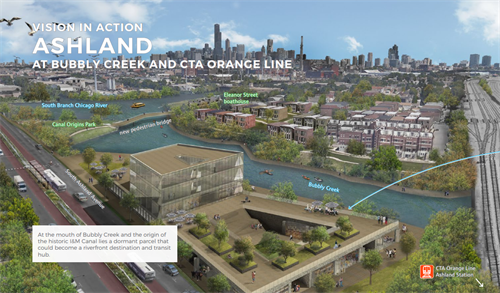Yesterday’s Zoning: Chicken Processing Facility Flies Under the Radar
This is the third part in a series about yesterday’s policies, today’s challenges, and tomorrow’s opportunities. Read part one here and part two here.

Across Bubbly Creek from new townhomes, the Studio Gang-designed Eleanor Boathouse at Park 571, and directly adjacent to another city park now sits Cougle Foods, a chicken processing facility. Located within the Pilsen Planned Manufacturing District, the recently constructed facility occupies a site along Bubbly Creek that was once highlighted as an opportunity to showcase the growing interest in Chicago’s rivers as public amenities.
How did we get here? The story of how another industrial development arose practically unannounced.
A surprise development review
During the October 22, 2019 meeting of the River Ecology & Governance Task Force, City of Chicago staff presented information about a proposed development for a vacant riverfront parcel at 2841 S. Ashland
After two hours, the meeting was cut short when a Park District employee shut off the lights for the night. Cougle’s proposal was approved by the Chicago Plan Commission a month later.
Avenue. The Cougle Commission Company, a Chicago-based poultry processor, was planning a move to the Bubbly Creek site, from its existing location in the rapidly re-developing Fulton Market. The members of the Rivers Task Force were expected to provide feedback on the design elements of the proposal, but instead raised questions about whether this site – adjacent to the river, new homes, two city parks, and an El station – was an appropriate location for a meatpacking facility, regardless of what the zoning allowed. Task Force members also questioned whether local community organizations and residents in Pilsen and Bridgeport had been notified and consulted.
A community meeting that left residents in the dark, literally
On November 20, 2019, a meeting was held in Bridgeport’s Eleanor Street Boathouse to present the Cougle proposal. The meeting was held by area aldermen who ultimately clarified that ‘tweaking’ the proposal was the only possible outcome after attendees questioned if industrial and commercial development was the best use for the site. Residents expressed fears of increased noise and air pollution, but officials noted that the site was zoned industrial and other potential uses would be non-compliant and conflict with nearby industrial users. After two hours, the meeting was cut short when a Park District employee shut off the lights for the night. Cougle’s proposal was approved by the Chicago Plan Commission a month later.
Outdated zoning fails to adapt to changing land uses
Originally conceived in the mid-1980s to limit industrial job loss, Chicago has 15 Planned Manufacturing Districts (PMDs) scattered across its zoning map. The location of those PMDs can be traced back to land use patterns from Chicago’s industrial past in the 19th and 20th centuries — a time when industry-located factories and warehouses were located along the city’s waterways for easy transportation of goods and materials. It was during this time that the notorious Stockyards dumped enough animal byproducts into the river that their decomposition caused the water to literally bubble, hence the name Bubbly Creek.
Zoning regulations currently allow for developments like the Cougle Foods facility to be built ‘as-of-right’ within the Pilsen PMD. This means that if a use aligns with a parcel’s zoning designation there is no requirement for community meetings or input or additional oversight from city agencies beyond the public review by the Chicago Plan Commission. This is why the Cougle plan was presented to residents in 2019 so late in the development process, leaving little room for meaningful input on what was effectively a ‘done deal’. Notably, under the newly passed Air Quality & Zoning Ordinance, if Cougle were proposed today, the developer would be required to meet a number of additional requirements.

Justin Bologna, MPC 2021, Cougle Foods land use and zoning map
Missed opportunities and potential for change
Some planning efforts have noted that vacant industrial parcels could be repurposed to better serve community residents and businesses. The Department of Planning and Development and other organizations have supported Equitable Transit-Oriented Development (eTOD) which promotes affordable and accessible mixed-use development near public transportation. The new Cougle Foods facility is located approximately 300 feet from the entry to the Ashland Orange line stop. Community plans, including Our Great Rivers, have highlighted the potential for eTOD and mixed-use development on the site as future community assets (see image below).

Rendering from Our Great Rivers, a visioning process conducted by MPC in partnership with the City of Chicago, shows an aspirational use for the site where Coogle Foods is now located.
Cougle Foods was presented to the community as the best possible fit for an existing vacant industrial site within a Planned Manufacturing District, but zoning changes in PMDs are not unheard of. In fact, the Kinzie Industrial Corridor Framework Plan, adopted in May 2019, reflected significant changes in planning, zoning, and land uses in Fulton Market as it transitioned from a meat-packing district to a commercial, corporate, and dining hub. These changes were factors in Cougle seeking to relocate from the Kinzie Corridor to Bubbly Creek.
The Cougle Foods case highlights the need for proactive change to city policy and zoning codes. In addition, it underscores the need for the City to be prepared with community-vetted ideas for where new and moving industries can be sited, and to proactively track and plan for precious riverfront land.
As in the case of the second post in this series, MAT Asphalt, the Chicago Zoning Code allows for industrial uses next to parks, rivers, and residential areas. The Cougle Foods site is adjacent to and across the river from public parks and new residential townhomes. It has direct access to Bubbly Creek and the Orange Line, but despite these opportunities, it was developed with little input from surrounding community members. The Cougle Commission Company and City officials are not bad operators, they are simply working within existing rules and frameworks. In fact, because of the site’s adjacency to Bubbly Creek, the design was required to comply with the Chicago River Design Guidelines which were passed in 2019. This meant presenting to the River Ecology and Governance Task Force for review and feedback, as well as incorporating a 60 foot setback from the shoreline, and including a publicly accesible pathway within that setback connecting to the adjacent Canal Origins Park. The Design Guidelines are one way that city officials are trying influence land uses close to Chicago’s waterways, but additional work is needed to make the process more community oriented.
The Cougle Foods facility demonstrates how landowners and industrial users can benefit from Chicago’s outdated development regulations and procedures, and how the lack of comprehensive zoning code updates that include considerations for equity, sustainability, and public health continue to fall short of balancing the needs of industrial land users and community residents.
Stay tuned for part four as MPC takes a deeper dive into the flaws of industrial land development in Chicago. We will review lessons that can be learned, how those lessons can be applied to the new citywide planning process, We Will Chicago, and demonstrate opportunities for equitable, responsive dialogue between developers, communities, and the City of Chicago to prosper.
